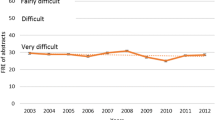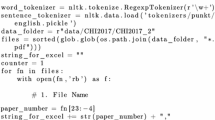Abstract
The value of scientific research is manifested in its impact in the scientific community as well as among the general public. Given the importance of abstracts in determining whether research articles (RAs) may be retrieved and read, recent research is paying attention to the effect of abstract readability on the scientific impact of RAs. However, to date little research has looked into the effect of abstract readability on the impact of RAs among the general public. To address this gap, this study reports on an investigation into the relationship between abstract readability and online attention received by RAs. Our dataset consisted of the abstracts of 550 RAs from 11 disciplines published in Science in 2012 and 2018. Thirty-nine lexical and syntactic complexity indices were employed to measure the readability of the abstracts, and the Altmetric attention scores of the RAs were used to measure the online attention they received. Results showed that abstract readability is significantly related to the online attention RAs receive, and that this relationship is significantly affected by discipline and publication time. Our findings have useful implications for making RA abstracts accessible to the general public.

Similar content being viewed by others
References
Adie, E., & Roe, W. (2013). Altmetric: Enriching scholarly content with article-level discussion and metrics. Learned Publishing, 26(1), 11–17.
Altmetric Website. (2020). Colors of the donut. Retrieved on 30 August 2020 from https://www.altmetric.com/about-our-data/the-donut-and-score/
Altmetric Website. (2021). How is the Altmetric Attention Score calculated?. Retrieved on 25 April 2021 from https://help.altmetric.com/support/solutions/articles/6000233311-how-is-the-altmetric-attention-score-calculated-
Benjamin, R. G. (2012). Reconstructing readability: Recent developments and recommendations in the analysis of text difficulty. Educational Psychology Review, 24(1), 63–88.
Bornmann, L. (2014). Do altmetrics point to the broader impact of research? An overview of benefits and disadvantages of altmetrics. Journal of Informetrics, 8(4), 895–903.
Brigham, T. J. (2014). An introduction to Altmetrics. Medical Reference Services Quarterly, 33(4), 438–447.
Chen, B., Deng, D., Zhong, Z., & Zhang, C. (2020). Exploring linguistic characteristics of highly browsed and downloaded academic articles. Scientometrics, 122(3), 1769–1790.
Coiro, J. (2021). Toward a multifaceted heuristic of digital reading to inform assessment, research, practice, and policy. Reading Research Quarterly, 56(1), 9–31.
Costas, R., Zahedi, Z., & Wouters, P. (2015). Do “altmetrics” correlate with citations? Extensive comparison of altmetric indicators with citations from a multidisciplinary perspective. Journal of the Association for Information Science and Technology, 66(10), 2003–2019.
Crossley, S. A., Skalicky, S., & Dascalu, M. (2019). Moving beyond classic readability formulas: New methods and new models. Journal of Research in Reading, 42(3–4), 541–561.
D’Angelo, C. A., & Di Russo, S. (2019). Testing for universality of Mendeley readership distributions. Journal of Informetrics, 13(2), 726–737.
Díaz-Faes, A. A., Bowman, T. D., & Costas, R. (2019). Towards a second generation of ‘social media metrics’: Characterizing Twitter communities of attention around science. PLoS ONE, 14(5), 1–18.
Didegah, F., & Thelwall, M. (2013). Which factors help authors produce the highest impact research? Collaboration, journal and document properties. Journal of Informetrics, 7(4), 861–873.
Dolnicar, S., & Chapple, A. (2015). The readability of articles in tourism journals. Annals of Tourism Research, 52, 161–166.
Dronberger, G. B., & Kowitz, G. T. (1975). Abstract readability as a factor in information systems. Journal of the American Society for Information Science, 26(2), 108–111.
Flesch, R. (1948). A new readability yardstick. Journal of Applied Psychology, 32(3), 221–233.
Gazni, A. (2011). Are the abstracts of high impact articles more readable? Investigating the evidence from top research institutions in the world. Journal of Information Science, 37(3), 273–281.
Graesser, A. C., McNamara, D. S., & Kulikowich, J. M. (2011). Coh-Metrix: Providing multilevel analyses of text characteristics. Educational Researcher, 40(5), 223–234.
Guerini, M., Pepe, A., & Lepri, B. (2012, June). Do linguistic style and readability of scientific abstracts affect their virality? In Proceedings of the 6th International AAAI Conference on Weblogs and Social Media (pp. 475–478). Dublin, Ireland.
Haberlandt, K. F., & Graesser, A. C. (1985). Component processes in text comprehension and some of their interactions. Journal of Experimental Psychology: General, 114(3), 357–374.
Hartley, J. (2000). Clarifying the abstracts of systematic literature reviews. Bulletin of the Medical Library Association, 88(4), 332–337.
Hartley, J., & Sydes, M. (1997). Are structured abstracts easier to read than traditional ones? Journal of Research in Reading, 20(2), 122–136.
Houghton, J. W., Henty, M., & Steele, C. (2004). Research practices and scholarly communication in the digital environment. Learned Publishing, 17(3), 231–249.
Htoo, T. H. H., & Na, J. C. (2017). Disciplinary differences in altmetrics for social sciences. Online Information Review, 41(2), 235–251.
Huang, W., Wang, P., & Wu, Q. (2018). A correlation comparison between Altmetric Attention Scores and citations for six PLOS journals. PLoS One, 13(4), e0194962.
Just, M. A., & Carpenter, P. A. (1980). A theory of reading: From eye fixations to comprehension. Psychological Review, 87(4), 329–354.
King, R. (1976). A comparison of the readability of abstracts with their source documents. Journal of the American Society for Information Science, 27(2), 118–121.
Kintsch, W., & van Dijk, T. A. (1978). Toward a model of text comprehension and production. Psychological Review, 85(5), 363–394.
Klare, G. R. (1963). The measurement of readability. Iowa State University Press.
Klare, G. R. (1974). Assessing readability. Reading Research Quarterly, 10(1), 62–102.
Larson-Hall, J. (2015). A guide to doing statistics in second language research using SPSS and R (2nd ed.). Routledge.
Laufer, B., & Nation, P. (1995). Vocabulary size and use: Lexical richness in L2 written production. Applied Linguistics, 16(3), 307–322.
Lei, L., & Yan, S. (2016). Readability and citations in information science: Evidence from abstracts and articles of four journals (2003–2012). Scientometrics, 108(3), 1155–1169.
Lu, C., Bu, Y., Dong, X., Wang, J., Ding, Y., Larivière, V., Sugimoto, C. R., Paul, L., & Zhang, C. (2019). Analyzing linguistic complexity and scientific impact. Journal of Informetrics, 13(3), 817–829.
Lu, X. (2010). Automatic analysis of syntactic complexity in second language writing. International Journal of Corpus Linguistics, 15(4), 474–496.
Lu, X. (2012). The relationship of lexical richness to the quality of ESL learners’ oral narratives. Modern Language Journal, 96(2), 190–208.
Lu, X. (2014). Computational methods for corpus annotation and analysis. Springer.
Lu, X., Casal, J. E., & Liu, Y. (2020). The rhetorical functions of syntactically complex sentences in social science research article introductions. Journal of English for Academic Purposes, 44, 100832.
Lu, X., Gamson, D. A., & Eckert, S. A. (2014). Lexical difficulty and diversity in American elementary school reading textbooks: Changes over the past century. International Journal of Corpus Linguistics, 19(1), 94–117.
Maflahi, N., & Thelwall, M. (2018). How quickly do publications get read? The evolution of Mendeley reader counts for new articles. Journal of the Association for Information Science and Technology, 69(1), 158–167.
McLaughlin, G. H. (1969). SMOG grading: A new readability formula. Journal of Reading, 12(8), 639–646.
Minnen, G., Carroll, J., & Pearce, D. (2001). Applied morphological processing of English. Natural Language Engineering, 7(3), 207–223.
Mohammadi, E., Thelwall, M., Haustein, S., & Larivière, V. (2015). Who reads research articles? An altmetrics analysis of Mendeley user categories. Journal of the Association for Information Science and Technology, 66(9), 1832–1846.
Newbold, N., & Gillam, L. (2010). The linguistics of readability: The next step for word processing. In Proceedings of the NAACL HLT 2010 Workshop on Computational Linguistics and Writing: Writing Processes and Authoring Aids (pp. 65–72). Los Angeles, California: Association for Computational Linguistics.
Ngai, C. S. B., & Singh, R. G. (2020). Relationship between persuasive metadiscoursal devices in research article abstracts and their attention on social media. PLoS One, 15(4), e0231305.
Nicholas, D., Huntington, P., & Watkinson, A. (2003). Digital journals, Big Deals and online searching behavior: A pilot study. Aslib Proceedings: New Information Perspectives, 55(1/2), 84–109.
OASIS Website. (2020). Why accessible summaries. Retrieved on 30 August 2020 from https://oasis-database.org/about
Perfetti, C. A. (2007). Reading ability: Lexical quality to comprehension. Scientific Studies of Reading, 11(4), 357–383.
Pinto, M., & Lancaster, F. W. (1999). Abstracts and abstracting in knowledge discovery. Library Trends, 48(1), 234–248.
Science Website. (2020a). Mission and scope. Retrieved on 30 August 2020 from https://www.sciencemag.org/about/mission-and-scope
Science Website. (2020b). Information for authors. Retrieved on 30 August 2020 from https://www.sciencemag.org/authors/science-information-authors
Science Website. (2020c). Instructions for preparing an initial manuscript. Retrieved on 30 August 2020 from https://www.sciencemag.org/authors/instructions-preparing-initial-manuscript
Sienkiewicz, J., & Altmann, E. G. (2016). Impact of lexical and sentiment factors on the popularity of scientific papers. Royal Society Open Science, 3(6), 160140.
Snow, C. E. (2010). Academic language and the challenge of reading for learning about science. Science, 328(5977), 450–453.
Stevens, R. J., Lu, X., Baker, D. P., Ray, M. N., Eckert, S. A., & Gamson, D. A. (2015). Assessing the cognitive demands of elementary school reading curricula: An analysis of reading text and comprehension tasks from 1910 to 2000. American Educational Research Journal, 52(3), 582–617.
Sud, P., & Thelwall, M. (2014). Evaluating altmetrics. Scientometrics, 98(2), 1131–1143.
Sugimoto, C. R., Work, S., Larivière, V., & Haustein, S. (2017). Scholarly use of social media and altmetrics: A review of the literature. Journal of the Association for Information Science and Technology, 68(9), 2037–2062.
Syamili, C., & Rekha, R. V. (2017). Do altmetric correlate with citation?: A study basedon PLOS ONE journal. COLLNET Journal of Scientometrics and Information Management, 11(1), 103–117.
Tankó, G. (2017). Literary research article abstracts: An analysis of rhetorical moves and their linguistic realizations. Journal of English for Academic Purposes, 27, 42–55.
Thelwall, M. (2018). Early Mendeley readers correlate with later citation counts. Scientometrics, 115(3), 1231–1240.
Thelwall, M., Haustein, S., Larivière, V., & Sugimoto, C. R. (2013). Do altmetrics work? Twitter and ten other social web services. PLoS ONE, 8(5), 1–7.
Toutanova, K., Klein, D., Manning, C., & Singer, Y. (2003). Feature-rich part-of-speech tagging with a cyclic dependency network. In Proceedings of the 2003 Human Language Technology Conference of the North American Chapter of the Association for Computational Linguistics (pp. 252–259). Edmonton, Alberta, Canada: The Association for Computational Linguistics.
Trueger, N. S., Thoma, B., Hsu, C. H., Sullivan, D., Peters, L., & Lin, M. (2015). The altmetric score: A new measure for article-level dissemination and impact. Annals of Emergency Medicine, 66(5), 549–553.
Vajjala, S., & Meurers, D. (2012, June). On improving the accuracy of readability classification using insights from second language acquisition. In Proceedings of the 7th Workshop on Innovative Use of NLP for Building Educational Applications (pp. 163–173). Montréal, Canada: Association for Computational Linguistics.
Verma, S., & Madhusudhan, M. (2019). An altmetric comparison of highly cited digital library publications of India and China. Annals of Library and Information Studies, 66(2), 71–75.
Weil, B. H. (1970). Standards for writing abstracts. Journal of the American Society for Information Science, 21(5), 351–357.
Wolfe-Quintero, K., Inagaki, S., & Kim, H.-Y. (1998). Second language development in writing: Measures of fluency, accuracy, and complexity. University of Hawaii Press.
Zahedi, Z., Costas, R., & Wouters, P. (2014). How well developed are altmetrics? A cross-disciplinary analysis of the presence of ‘alternative metrics’ in scientific publications. Scientometrics, 101(2), 1491–1513.
Funding
This research was supported by a grant from the National Social Science Fund of China (18BYY110) to the first author.
Author information
Authors and Affiliations
Contributions
TJ: Conceptualization, Methodology, Writing—review & editing. HD: Data curation, Investigation, Writing—review & editing. XL: Conceptualization, Methodology, Writing—review & editing. JN: Methodology, Investigation, Writing—review & editing. KG: Methodology, Investigation, Writing—review & editing.
Corresponding author
Rights and permissions
About this article
Cite this article
Jin, T., Duan , H., Lu, X. et al. Do research articles with more readable abstracts receive higher online attention? Evidence from Science. Scientometrics 126, 8471–8490 (2021). https://doi.org/10.1007/s11192-021-04112-9
Received:
Accepted:
Published:
Issue Date:
DOI: https://doi.org/10.1007/s11192-021-04112-9




